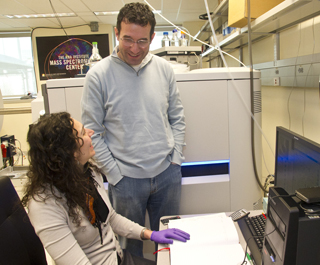UAlbany's RNA Institute Building Critical Mass of Research Expertise
 Related Photos
Related Photos
The University at Albany has recently recruited a new team of research scientists, all specialists in the use of mass spectrometry, to explore and develop the next generation of RNA-based drug therapies specifically targeting infectious diseases, such as HIV.
Established in the spring of 2010 under the direction of Paul Agris, the RNA Institute has become a nexus of advanced technology and an international cadre of talented researchers, including the mass spectrometry team headed by Professor Dan Fabris.
 |
|
Dan Fabris and Maria Basanta Sanchez of UAlbany's RNA Institute (Photo Mark Schmidt) |
The new team includes two post-doctoral fellows, a research scientist, three UAlbany graduate and four undergraduate students -- each with unique skills and interests -- but linked by a common goal of developing and delivering novel innovative medicines, vaccines and diagnostics.
"I was looking for scientists with a range of expertise but a common goal: to go into the 'uncharted territory' of RNA discovery using mass spectrometry," said Fabris. Mass spectrometry is a method for identifying the chemical constitution of a substance by separating its ions according to their differing mass and charge.
"This is the dark area of biology that we should go into," said Fabris, mentioning how much of the research to date on RNA may fall victim to the "looking for keys under the lamp post" syndrome. In RNA parlance, it is the equivalent of limiting study and targeting therapies only for those sequences currently understood. "In biology, we are in this limited light of the lamp post, but we need to understand what's happening outside this light if we are to make significant therapeutic contributions to the most difficult of diseases," said Fabris.
The RNA Institute’s newest members are:
- Maria Basanta Sanchez, a research scientist and expert in ion mobility spectrometry. Basanta Sanchez hails from Spain, and received her Ph.D. from the University of Manchester in the United Kingdom in 2007.
- Papa-NiiAsare-Okai, a post-doctoral research associate and expert in nucleic acid chemistry. A native of Ghana, Asare-Okai earned his Ph.D. from Wayne State University in 2010.
- John Brad Mangrum, a post-doctoral research associate and expert in high-resolution mass spectrometry. A native of Virginia, Mangrum received his Ph.D. from Virginia Commonwealth University in 2010.
Fabris, who heads the Institute's Mass Spectrometry Center, was recently awarded a $1,768,690 grant from the National Institutes of General Medical Sciences (NIGMS) to analyze RNA-based therapeutic strategies in the treatment of HIV.
Equipped with a state-of-the-art collection of instruments and enabling technologies provided through the RNA Institute's strategic partnerships, Fabris and his colleagues are embarking on projects aimed at reaching a greater understanding of the role of noncoding RNA in gene regulation and viral replication. These insights will lead to the identification of possible targets for early drug discovery that could produce alternative drugs for resistant strains of infectious diseases and new treatments for orphan diseases.
Joining the professional staff are grad students Ryan Quinn (Chemistry/Albany N.Y.), Jennifer Lippens (Chemistry/Los Angeles), and Rebecca Rose (Chemistry/Poughkeepsie N.Y.). In addition, undergraduate students Chelsea Krzemien (Biology/Buffalo N.Y.), Mohammed Mishal Makshood (Biology/Sri Lanka), and Nicoletta Gallo (Biology/New York City) assist lab members in a variety of support roles while learning the necessary skills to pursue a career in RNA-based research.
The RNA Institute also provides students from other universities and colleges with internship opportunities. Jackie Sayre of Suffern, N.Y., studies chemistry at the College of Saint Rose while working in the Fabris lab.
The RNA institute fosters a collaborative environment among faculty members across disciplines, such as biological sciences, chemistry, public health, bioinformatics and nanosciences. "I work with vacuum, but not in a vacuum. We need to learn from each other," said Fabris, noting how The RNA Institute has flourished thanks to the support of New York State and private firms such as Krackeler Scientific.
![]() For more news, subscribe to UAlbany's RSS headline feeds
For more news, subscribe to UAlbany's RSS headline feeds
Educationally and culturally, the University at Albany-SUNY puts "The World Within Reach" for its 17,500 students. An internationally recognized research university with 50 undergraduate majors and 125 graduate degree programs, UAlbany is a leader among all New York State colleges and universities in such diverse fields as public policy, nanotechnology and criminal justice. With a curriculum enhanced by 300 study-abroad opportunities, UAlbany launches great careers. For more information about this globally ranked University, visit https://www.albany.edu/. For UAlbany's extensive roster of faculty experts, visit www.albany.edu/news/experts.shtml.




